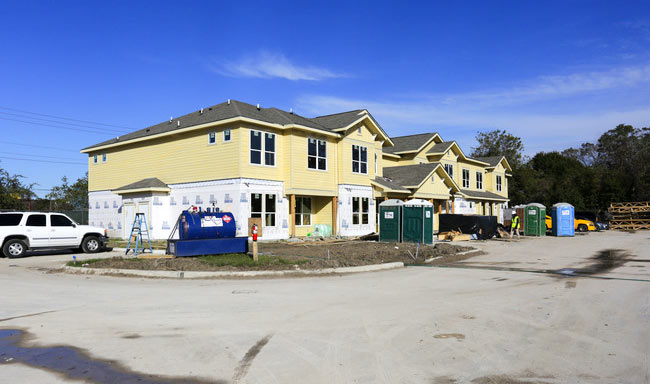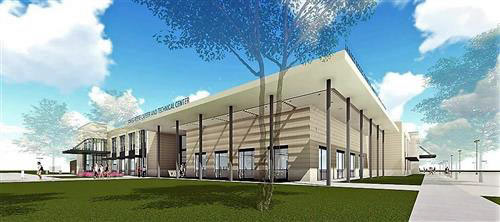HHA’S FIRST NEW MIXED-INCOME COMPLEX IN A DECADE DEBUTS AT CROSSTIMBERS AND N. MAIN  The Houston Housing Authority has finished building its first development in 10 years: the 154-unit Independence Heights Apartments. Situated at the southeast corner of Crosstimbers and N. Main St., the garden-style complex has units available to tenants who earn less than $41,500 per year and have qualified for public housing vouchers. (The median household income in Independence Heights is around $25,000.) Mayor Turner okayed the project back in November, 2016 — 2 months after he killed a similar mixed-income complex that had been proposed for Briargrove, in place of one of the housing authority’s own office buildings on Fountain View Dr. That decision prompted a federal investigation in which HUD eventually found that the city’s rejection “was motivated either in whole or in part by the race, color or national origin of the likely tenants.” Of the $45 million Houston has received from HUD since 2011 (in response to Hurricane Ike) only $12 million has been spent — all of it on this just-built project. [Previously on Swamplot] Photo of Independence Heights Apartments under construction: Apartments.com
The Houston Housing Authority has finished building its first development in 10 years: the 154-unit Independence Heights Apartments. Situated at the southeast corner of Crosstimbers and N. Main St., the garden-style complex has units available to tenants who earn less than $41,500 per year and have qualified for public housing vouchers. (The median household income in Independence Heights is around $25,000.) Mayor Turner okayed the project back in November, 2016 — 2 months after he killed a similar mixed-income complex that had been proposed for Briargrove, in place of one of the housing authority’s own office buildings on Fountain View Dr. That decision prompted a federal investigation in which HUD eventually found that the city’s rejection “was motivated either in whole or in part by the race, color or national origin of the likely tenants.” Of the $45 million Houston has received from HUD since 2011 (in response to Hurricane Ike) only $12 million has been spent — all of it on this just-built project. [Previously on Swamplot] Photo of Independence Heights Apartments under construction: Apartments.com





So is 78k per door including the land in that area reasonable? I’m asking seriously. Anyone here know?
That’s an interesting little pocket of the city. Across North Shepherd is the (recently) skyrocketing GOOF area with 500k-$1M homes, just north of there is Northside, also with homes who’s values can exceed $1M. But that particular corner at Cross Timbers and North Main is a pocket of really depressed properties, with some signs of moderately priced townhomes starting to develop. I wonder how this area will look in another 10 years. Houston is such a mixed salad of economic micro-communities compared to other more delineated cities in the mid-west where there is typically a single street that marks the “good’ from the ‘bad’ parts of town.. Maybe the impact of government housing will be a drop in the bucket? When I worked downtown and came home west on Dallas St. it was a blighted mess of falling down row houses and I always thought it interesting that it was so close to River Oaks.
“just north of there is Northside, also with homes who’s values can exceed $1M.”
*south
Nice Neighbor: Back in the day, the fine folks that worked for the rich folks in River Oaks lived in those falling down row houses. And the reason they were so close to River Oaks was so the fine folks could WALK to work
$78K per door is very reaonable if that’s the actual cost. I’m a bit skeptical about that figure.
IIRC, the Briargrove project was going to be in excess of $200K per door.
If the project is income related, and not skin tone related, how about we don’t make assumptions as to the likely skin tone of the residents?
.
Some people don’t want a project built for poor people next to them. Sounds mean but it’s true. That doesn’t make them racist. “Classists” maybe. Not racists.
Nice: We do have such lines. Look at 288. I have properties JUST west of 288 that rent for $1000 for a studio. Then JUST east of 288 (these two properties are about 3/4 a mile apart), I have 2 bedrooms that I have a hard time renting for $700. And it’s still centrally located between midtown and med center.
.
tldr: 288 is an example of that ‘line’ you’re talking about.
I’m happy to see new affordable housing.
Cody, In the midwestern towns where I grew up, the suburbs were 100% clean, safe (leave your doors unlocked kind of safe), and middle or upperclass. The “cities’ might be were Dad went to work, but he left before the sun set. My folks were shocked that when we moved to Texas in the early 90’s we didn’t buy in the suburbs. They were horrified for our safety. There is even a documentary on Kansas City (where both my parents grew up) about Troost Avenue. I see your point regarding 288, but if you ever look at the demographic/socioeconomic maps of Houston its really a mixed bag. In cities like St. Louis and Kansas City, the differences are more shocking. Literally every 16 year old kid learning to drive in St. Louis learned that when you saw the sign for East St. Louis you take the exit and turn around, you NEVER drive past it. If you know anyone who grew up there, ask them. They will laugh because it’s true..
.
All of this is a really high praise for Houston. I think that however Houston evolved it is much easier to mix in low income housing here and there, have inclusive schools, and still keep people in areas of opportunity. I cannot imagine if someone stuck a housing project in the middle of Chesterfield, Missouri. It would be set ablaze mysteriously in the middle of the night, I suspect.
https://www.youtube.com/watch?v=UJS9aPW8kd4
This is very representative of cities in the midwest. It highlights what is a much starker division than $300/month difference in rent, per the HWY288 comment. Compare and contrast to what we have in Houston. I think other cities could learn from how Houston has developed. Sure, it isn’t nirvana, but it is a very inclusive city and with very little social friction comparative to many.
Interesting that HUD decided our mayor is a racist. He is corrupt, and a petty tyrant but not racist. More on point, it is good that HHA finally did their job and built housing rather than just paying salaries for employeees who arent providing housing.
Oh man, the St. Louis stuff is so true and so sad. I have a grandparent in Ellisville just below Chesterfield. The complete and total lack of diversity is mind-blowing and downright scary / threatening considering it’s the 21st century and all.
Grew up in StL. All true, but the true dividing line isn’t ESL (who goes to Illinois?)
It’s Delmar Boulevard
http://www.businessinsider.com/colin-gordon-maps-white-flight-in-st-louis-2014-8
@Longhorn: Where’d you go to high school? :-)
Regarding Delmar, YES, but thought the ESL ref might be more recognizable to a layman. Houston resembles nothing of the segregated cities in the Midwest. St. Louis is not alone, and I think it must have had a lot to do with where the cities were in development cycle post WWII and redlining practices in the decades leading up to the 1980s.
Need help finding a cheap but nice apt 2.2 on fix income 1500.a monthly